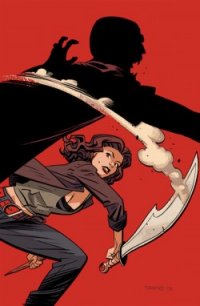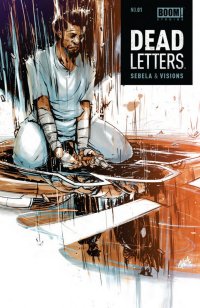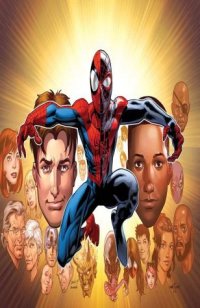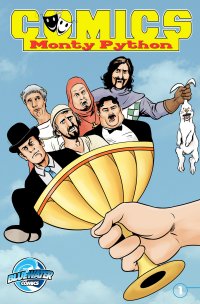Angel & Faith Season 10 #1 (Dark Horse, $3.50)
By Cat Taylor
When Dark Horse first launched the new direct-to-comic seasons of Buffy the Vampire Slayer and Angel that picked up right where the television series ended, I was a faithful reader. I read most of the first years’ worth of both comics and was pretty pleased, thinking they captured the voices of the characters and took the comic series to places that they couldn’t really go on television. By the time Joss Whedon started downplaying his role in the comic book adaptations the novelty was starting to wear off. So, I drifted away. Now that season 10 of both series has been launched I decided to give Angel, or as it’s known now, Angel & Faith another shot. Fortunately and unfortunately, my opinion hasn’t really changed after reading issue #1.
As with the writers on the older comic book seasons, the new writer, Victor Gischler, does a pretty good job of capturing the “voice” of the character of Angel. It’s always a testament to a good adaptation when you can hear and see the actors from the television series in the characters on the page. This issue isn’t quite as effective at capturing the television persona of Faith, but on the television series she was always a secondary character and only had a few episodes where she was explored on a deeper level. Since she’s going to be a major character in this series, and Gischler is already exploring her inner self, I’ll give him a little pass on that and wait to see where he’s going. The artist of this issue, Will Conrad, is a good match for Gischler. He’s certainly a more than competent comic book artist. He captures the look of the characters well and conveys action, backgrounds, etc. at the level most readers would hope.
Plot wise, this issue isn’t a strong season opener. If it were an episode of the television series, it would feel like a forgettable mid-season, non-sweeps, stand-alone episode. So far, I’m just not sold on a bunch of demonic pixies as this season’s “big bad” and not much beyond the ordinary for a day in the life of Angel happens. Of course, every day in the life of someone like Angel is pretty exciting, but you know what I mean, comparatively. The exception to my statement about it being a forgetting episode is the direct crossover with the current events in the first issue of Buffy the Vampire Slayer season 10. Also, despite the brief summary of season 9 on the inside cover, missing the last year or so of comics left me pretty clueless as to how everybody got to where they are in this issue. For the most part, that’s not a big deal since enough is explained along the way, but there are a few characters shown in this issue about whom I know nothing and learned nothing. Once again, not that big of a deal for the most part, but there’s a big reveal at the end that is apparently supposed to be a big surprise return, but I have no idea who that character is. Well, I guess I have to start catching up somewhere.
Rating: 




Out of a Possible 5 Stars
Dead Letters #1 (Boom!, $3.99)
By Jeb D.
I don’t know if it’s a search for identity, or just coincidence, but of late, Boom! Studio has found themselves a strong niche in modern crime comics (Hit, 2 and/or 3 Guns, etc.). The newest, and potentially strongest, arrives this week from writer Christopher Sebela and artist Chris Visions, with colors from Ruth Redmond.
The setup is a familiar one: our protagonist is Sam, who wakes up in a filthy hotel room, not knowing who or where he is, though the bandages on his wrists are the first clue that this is something more than the usual head trauma that men in dangerous professions routinely suffer in the comics. Naturally, bad guys burst through the door, guns blazing, and Sam discovers that muscle memory brings back a set of lethal skills that he still can’t quite remember, but which provide him an edge as he goes on the run.
Of course, after that introduction, the reader is pretty much ahead of the game: we know that Sam will spend the next 20-odd pages interacting with, chasing, and running from characters who know more about what’s going on, and about himself, than he does; they will speak cryptically, task him with things he only half understands, and condescend to his ignorance; then, on the last page, they’ll casually drop a bombshell that will bring everything into focus. In this specific case, the bombshell will probably provoke an equal measure of intrigue and of eyeroll, but the vitality of the storytelling leading up to it keeps the momentum going for the next issue.
I wonder if Sebela had originally intended Sam’s interior monologue to be as wordy and incessant as it is, or if some of this was his reaction to Visions’ art: it’s fantastically vigorous and alive, rough-edged, hugely kinetic, and impatient to move the story along, leaving the reader gasping to keep up with the gun battles and car chases: in other words, it’s often willing to sacrifice clarity for action, and there really are spots where the narration is the only thing keeping the events of the story comprehensible. Comics being the visual medium that they are, I’m willing to make that tradeoff: it’s not every day you run into an artist that can drive a script as urgently as Visions does here (though last week’s Ghost Rider #1 produced a similar reaction from Tradd Moore’s equally compelling, if aesthetically quite different, art) , but Sam’s narration can feel pretty repetitive and on-the-nose as he attempts to make sense of his new circumstances’ combination of familiarity and alienation. Unusually for a newcomer, Visions is also part of the growing trend of comic-book artists who are actually able to create individually distinct visual depictions for characters of color.
If Dead Letters carries a certain sense of running off a familiar noir playbook, it has also set for itself a conflict that opens up some unusual possibilities for the form, though at this point, Sebela’s scripting (as opposed to his overall concept) isn’t as compelling as one could hope for. That’s far more than made up for by Vision’s art, which has exactly the right blend of street-level grit and comic-book exaggeration to make Dead Letters feel like something very special, despite the derivative nature of its setup.
Rating: 




Out of a Possible 5 Stars
Ultimate Spider-Man #200 (Marvel, $4.99)
By Cat Taylor
Being one of the old-school Marvel fans who started reading as a child and has continued through well into adult years when I should have outgrown comics, I never got into the Ultimate universe. I appreciate that Marvel has been trying to introduce young fans to their characters from the beginning without being tied to decades of continuity, and I am happy that they didn’t destroy the current continuity to do it (cough – New 52 – cough), but since I’ve been happy with the versions I grew up with, the reimaginings didn’t really interest me. So, prior to this issue, I had only read issue number one and one of the earliest Miles Morales issues of Ultimate Spider-Man.
I picked up this issue because I was intrigued by the premise. For this landmark 200th issue, the characters who were closest to the Ultimate Peter Parker have gathered for a two-year memorial wake to honor his death. There’s a lot of potential in a premise like that to see what each character remembers and chooses to share, and what a great way to recognize a character who died before reaching the promise that all of us old-school Marvel fans know that he had because he’s still alive in the primary Marvel universe. Plus, Brian Michael Bendis wrote the issue, and he’s one of Marvel’s better writers when it comes to getting to the heart of his characters. Therefore, I was very surprised to be let down by most of this issue.
First, while I’m too old to know what teenagers in 2014 are really like, the teenagers, as written in this issue, sound exactly like someone as clueless as me wrote them. Their dialogue doesn’t sound natural, and “hip” modern social-media slang seems forced from their mouths. Furthermore, there is nothing to distinguish the personalities of the many characters in this issue. All of the girls are quiet and bland. The guys are either equally bland or stupidly cocky. If not for the art, I would challenge any reader to tell one character from another. It’s possible that you may not be able to visually distinguish them either, but each sequence in this issue was drawn by a different artist. So, that helps.
The wake serves as a framing structure in this comic while each sequence is an imagining from different characters of what would have happened if Peter Parker had lived. Even these imaginings aren’t all that different from one another. In one form or fashion, Parker as Spider-Man is a leader who uses his skill and intelligence to lead others and transform the world of crime fighting. I guess it’s somewhat ironic, but not unexpected, that Parker’s friends’ fantasies of him are far greater than he became in the primary Marvel universe (dang it, what number is that universe? Is it 616, or is that just Rey Mysterio’s finisher?) .
Where this issue almost saves itself and carries the emotional weight that one would hope for an issue like this is in the final sequence where Parker’s memory inspires the wake attendees to do a heroic deed in his honor. I won’t give it away since it’s the best thing about the whole story, but it’s a deed perfectly suited to the characters present and not an artificially forced situation like Aunt May punching out Dr. Doom or anything as ridiculous as that.
Finally, despite my misgivings about this issue, I like that Marvel has used the Ultimate universe to give us an entirely new and different Spider-Man by killing their version of Peter Parker early in his career. Of course, in comics most characters don’t stay dead. Even when the comic book universe has adapted well without them and bringing them back is unnecessary and weakens the significance of their deaths (role call: Barry Allen, Hal Jordan, Bucky Barnes, Jason Todd, Jean Grey…), comic book writers love to find ways to resurrect characters even years after it matters. So, I hope the hint of the Ultimate Peter Parker’s return that is casually dropped in this issue is only a tease. We have a living Peter Parker over in the other Marvel universe for those who miss him. For once, please let the dead stay buried and let Miles Morales take the Ultimate Spider-Ball and run with it.
Rating: 




Out of a Possible 5 Stars
 Comics: Monty Python (Bluewater Comics, $3.99)
Comics: Monty Python (Bluewater Comics, $3.99)
By Jeb D.
My initial impression of this comic was an alarming one: everyone’s favorite low-rent “reality” comic press attempting to recreate the anarchic spirit of Monty Python’s Flying Circus. And the first few pages fall depressingly in that vein, as we’re introduced to a pair of young BBC network flacks attempting to assemble some kind of 45th Anniversary Python tribute, full of pratfalls and absurdities, followed by a bowler-hatted “Mr. Jeeves” doing a Python-esque parody of a BBC announcer accidentally walking off a cliff into the ocean.
For better or worse, this conceit quickly fades, and we’re left with something that is less ambitious than trying to match the Pythons at their own game, but not significantly more rewarding: a fairly drab recounting of the troupe’s history.
Writer Chris Canibano’s script consists of a series of plain, dry, well-researched narrative boxes, piled high with dates and details (and the occasional spelling and grammatical errors that you might expect to find in a comic with no credited editor). There’s already a fair amount of biographical material about The Pythons out there (including the massive hardcover book of the same name), but anyone whose curiosity can be better satisfied with a quick ten-minute overview might find this informative, if not particularly entertaining.
Making this a more stimulating experience than just Wikipedia’ing the Pythons is the artist’s job, and Juan Luis Rincon gives it his best shot in a flat, cartoony style, with lots of spaciousness. While there are no credits or disclaimers about use of the Pythons’ likenesses, he gets just close enough to the real actors’ faces to assume that was his intention, but not close enough that, out of context, most readers would know who they were supposed to be. Since a lot of the book is given over to scenes of things like script meetings and BBC offices, he doesn’t have a lot to work with, but anyone who can make something like John Cleese’s classic “silly walks” routine look dull and inflexible is probably better off keeping things simple. Rincon provides his own colors, and they’re bright and appealing; if the art doesn’t exactly draw you into Canibano’s stodgy narration, it provides a functional, non-distracting framework.
A respectable effort; not really a four dollar purchase.
Rating: 




Out of a Possible 5 Stars